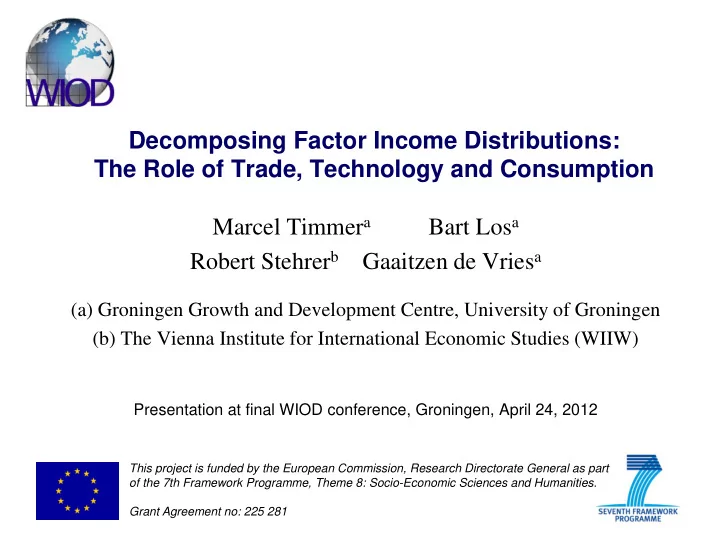

Decomposing Factor Income Distributions: The Role of Trade, Technology and Consumption Marcel Timmer a Bart Los a Robert Stehrer b Gaaitzen de Vries a (a) Groningen Growth and Development Centre, University of Groningen (b) The Vienna Institute for International Economic Studies (WIIW) Presentation at final WIOD conference, Groningen, April 24, 2012 This project is funded by the European Commission, Research Directorate General as part of the 7th Framework Programme, Theme 8: Socio-Economic Sciences and Humanities. Grant Agreement no: 225 281
Background Increasing income inequality within countries in past decades, both in advanced and emerging economies (Autor, 2010; Goldberg and Pavcnik, 2007) Various determinants have been suggested both in theory and empirics (see key-note Adrian Wood): International trade Skill biased technological change (SBTC) Conclusion of older literature (cross-country empirics) : SBTC is dominant explanation (e.g. Michaels et al. 2010) New trade channels: Increasing global production sharing (Feenstra and Hanson, 1999; Costinot, Vogel and Wang 2012) Changes in patterns of consumption (Yi and Zhang, 2010)
Background Contribution of this paper: a new ex post decomposition analysis of income inequality within countries relying on an input-output modelling of world production, including trade in intermediate goods and services Decompose wage income inequality within 40 countries across workers with different skills into: Changes in relative wages Changes in labour quantities needed to produce products (includes off-shoring of activities and technological change in global production) Changes in final demand for products New method inspired by input-output decomposition techniques from Leontief (1949) in a multi-regional setting (related to recent work by e.g. Yi, Johnson and Bems, 2011, 2012)
Methodology Define product as final good produced in industry i in country j All activities needed to produce a product (i,j) is denoted by shorthand global production of (i,j) Workers are of different skill classes (s) Decompose the change in income of worker s in country j over period 1995-2008 into: Change in wage for ( s,j ) Change in number of workers ( s,j ) needed in global production of product ( i,x) Change in share of country j in total s needed for ( i,x ) (depends on trade in activities; if x=j this is “off-shoring”) Change in s needed for production of ( i,x ) (technical change in global production) Changes in final demand for product ( i,x )
Methodology and Data World input output tables (from WIOD) for global production structure ( A ) and final demand ( e f ) Quantities of labour used by skill (by industry and country, l ) (WIOD) Wages of labour used by skill (by industry and country, w ) (WIOD) Efficiency levels of labour of a skill type across countries ( π , GGDC productivity level database)
Example: Global production of car from German transport industry Income earned in global production of German car (1995 and 2006) 100 USA USA KOR KOR JPN JPN CHN CHN ROW ROW 80 Other EU Other EU 60 Shares (%) 40 DEU DEU 20 0 1995 2006
Example: Global production of car from German transport industry Income earned in global production of German car (1995 and 2006) 100 80 ROW High skill labour ROW High skill labour ROW Med skill labour 60 Shares (%) ROW Low skill labour ROW Med skill labour Own High skill labour ROW Low skill labour Own High skill labour 40 Own Medium skill labour Own Medium skill labour 20 Own Low skill labour Own Low skill labour 0 1995 2006
Example: Global production of car from German transport industry Decomposition of income of low skilled workers in various countries involved in the global production of final output from the German transport equipment industry (ratio of 2008 over 1995 in current $) Low-skilled Total Wage Share in wage per workers Workers income worker needed needed DEU 0.58 1.67 0.69 0.50 CZE 3.06 3.90 1.57 0.50 HUN 2.41 1.83 2.63 0.50 POL 1.55 1.59 1.95 0.50 SVK 1.42 0.57 4.98 0.50
Example: Global production of car from German transport industry Decomposition of income of low skilled workers involved in the global production of final output from the German transport equipment industry (ratio of 2008 over 1995 in current $) Low-skilled High-skilled Total Wage Share in Total Wage Share in wage per workers wage per workers Workers Workers income worker needed needed income worker needed needed DEU 0.58 1.67 0.69 0.50 1.01 1.99 0.70 0.72 CZE 3.06 3.90 1.57 0.50 5.09 3.83 1.84 0.72 HUN 2.41 1.83 2.63 0.50 5.33 2.51 2.95 0.72 POL 1.55 1.59 1.95 0.50 5.38 1.53 4.87 0.72 SVK 1.42 0.57 4.98 0.50 4.98 0.73 9.44 0.72
More examples Low-skilled High-skilled Total Wage Share in Total Wage Share in wage per workers Workers wage per workers Workers income worker needed needed income worker needed needed China electronics China 0.47 2.81 0.87 0.19 1.70 3.56 0.59 0.81 Japan 0.41 1.11 1.92 0.19 1.15 1.14 1.25 0.81 Korea 0.44 1.15 2.01 0.19 2.39 1.30 2.25 0.81 US transport US 0.55 1.44 0.75 0.51 1.12 1.62 0.95 0.73 Mex 1.11 2.32 0.93 0.51 1.62 2.38 0.93 0.73
Conclusions and Next steps Preliminary conclusions: Decomposition is feasible and has intuitive interpretations New measure of biased technological change in a global production system setting Find strong evidence of skill-bias in global production Next steps: Make decompositions for global production of all products Add in the changes in demand for various products (e.g. increasing demand for durables; increasing demand for final products from China) Fully decompose the change in labour income across workers in each country
Recommend
More recommend